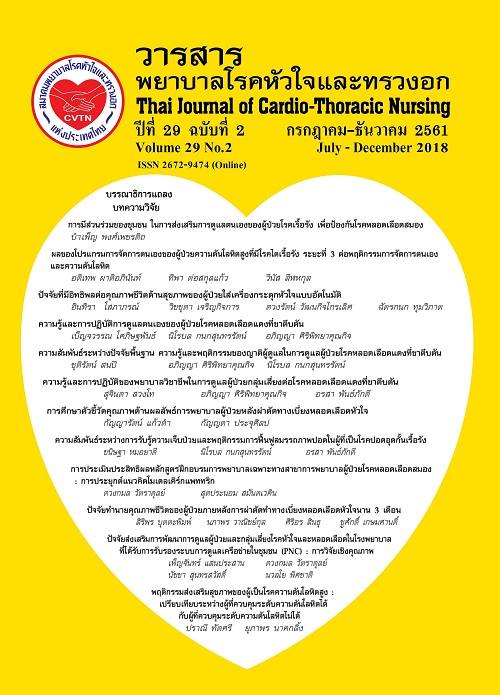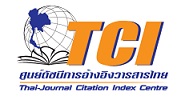Relationships between illness perception and pulmonary rehabilitation behaviors in persons with chronic obstructive pulmonary disease
Keywords:
illness perception, pulmonary rehabilitation behaviors, chronic obstructive pulmonary diseaseAbstract
This descriptive study aimed to examine the relationship between illness perception and pulmonary rehabilitation behaviors in persons with chronic obstructive pulmonary disease (COPD). The sample consisted of 55 patients who were diagnosed with chronic obstructive pulmonary disease and sought treatment of the Respiratory Clinic at the Outpatient Department, a tertiary hospital in Bangkok. The data were collected using 4 questionnaires: 1) Personal Information, 2) Brief Illness Perception, 3) Perceived Benefits, Support, Barriers about Pulmonary Rehabilitation Behaviors, and 4) Pulmonary Rehabilitation Behaviors. Data were analyzed using descriptive statistics and Pearson’s product moment correlation coefficient.
Results revealed that most of the participants perceived that pulmonary rehabilitation was a part of medical treatment and was benefit for their health. The information and emotional support from health care providers promoted them to practice pulmonary rehabilitation. The correlational analysis showed that participants' belief about their illness control ability with pulmonary rehabilitation, and the understanding about their illness (COPD) were significantly correlated with the pulmonary rehabilitation behaviors (r = .34, p < .05; r = .34, p < .05, respectively).
This study suggested that healthcare team should promote interventions to increase patient pulmonary rehabilitation capability. In addition, nurses should provide information about illness to enhance pulmonary rehabilitation behaviors in persons with COPD constantly.
References
2. Bureau of Policy and Strategy. Public health statistics in 2012. Nonthaburi: Office of the Permanent Secretary Ministry of Public Health; 2012.
3. The Royal College of Physiatrists of Thailand. Guideline and management of COPD in Thailand. 2005 [cited 2014 August 20].
Available from:https://www.rehabmed.or.th/royal/rc.thai/ (in Thai).
4. Buranachonapa P. Effectiveness of pulmonary rehabilitation in COPD patients. Bangkok: Academic papers Division of Physical Therapy; 2012. (in Thai).
5. Haemawichaiwat R. Pulmonary rehabilitation and family support program to improve quality of life among COPD patients. Lampang Medical Journal. 2009; 30(1): 9-17. (in Thai).
6. Guell R, Resqueti V, Sangenis M, Morante F, Martorell B, Casan P, et al. Impact of pulmonary rehabilitation on psychosocial morbidity in patients with severe COPD. Chest. 2006; 129(4): 899-904.
7. von Leupoldt A, Hahn E, Taube K, Schubert-Heukesoven S, Magnussen H, Dahme B. Effect of 3-week outpatient pulmonary rehabilitation on exercise capacity, dyspnea and quality of life in COPD. Lung. 2008 Nov-Dec;186(6):387-91. doi: 10.1007/s00408-008-9089-3. Epub 2008 Apr 12
8. Fischer MJ, Scharloo M, Abbink JJ, van’t Hul AJ, van Ranst D, Rudolphus A. et al. Drop out and attendance in pulmonary rehabilitation: the role of clinical and psychosocial variables. Respir Med. 2009; 103(10): 1564-71.
9. Garrod R, Marshall J, Barley E, Jones PW. Predictors of success and failure in pulmonary rehabilitation. Eur Respir J. 2006; 27(4): 788-94.
10. Leventhal H, Nazenz DR, Steel DJ. Illness representations and coping with health threats. In: Baum A, Taylor S.E, Singer J.E, Eds. Handbook of psychology and health: social psychological aspects of health. Erlbaum: Lawrence Erlbaum Associate Inc; 1984.p.219-252
11. Wiratchai N. Thesis guideline. Division of Research Education. Bangkok: Faculty of Education. Chulalongkorn University; 2003.
12. Pfeiffer E. A shot portable mental status questionnaire for the assessment of organic brain deficit in elderly patients. J Am Geriatr Soc. 1975; 23(10): 433-41.
13. Broadbent E, Petrie KJ, Main J, Weinman J. The brief illness perception questionnaire. J Psychosom Res. 2006; 60: 631-7.
14. Sowattanangoon N. The brief illness perception questionnaire. 2006. [cited 2015 December 28] Available from https://www.uib.no/ipq/pdf/B-IPQ-Thai.pdf
15. Bonsaksen T, Haukeland-Parker S, Lerdal A, Fagermoen MS. A 1-year follow-up study exploring the associations between perception of illness and health-related quality of life in persons with chronic obstructive pulmonary disease. Int J Chron Obstruct Pulmon Dis. 2014; 9(1): 41-50.
16. Zoeckler N, Kenn K, Kuehl K, Stenzel N, Rief W. Illness perceptions predict capacity and psychological well-being after pulmonary rehabilitation in COPD patients. J Psychosom Res. 2014; 76(2): 146-51.
17. Calverley PM, Anderson JA, Celli B, Ferguson GT, Jenkins CR, Jones PW. et al. Salmeterol and fluticasone propionate and survival in chronic obstructive pulmonary disease. N Eng J Med. 2007;356: 775-89.
18. Calverley PM, Boonsawat W, Cseke Z, Zhong N, Peterson S, Olsson H. Maintenance therapy with budesonide and formoterol in chronic obstructive pulmonary disease. Eur Respir J. 2003 Dec; 22(6):912-9.
19. Jenkins CR. Jones PW, Calverley PM, Celli BR, Anderson JA, Ferguson GT. et al. Efficacy of salmeterol/ fluticasone propionate by GOLD stage of chronic obstructive pulmonary disease: analysis from the randomised, placebo-controlled TORCH study. Respir Res. 2009 Jun 30;10:59. doi: 10.1186/1465-9921-10-59.
20. Panpanya R. Clinical nursing practice guideline: pulmonary rehabilitation in COPD patients. Journal of Development Research 2014; 7(3): 11-15. (in Thai).
21. Gruffydd JK, Langley JC, Dyer C, Badlay K, Ward S. What are the needs of patients following discharge from hospital after an acute exacerbation of chronic obstructive pulmonary disease. Prim Care Respir J. 2007; 16(6): 363-8.
22. Fischer MJ, Scharloo M, Abbink JJ, van’t Hul AJ, van Ranst D, Rudolphus A., et al. The dynamics of illness perceptions: testing assumptions of Leventhal’s common-sense model in a pulmonary rehabilitation setting. Br J Health Psychol. 2010; 15(4): 887-903.
Downloads
Published
How to Cite
Issue
Section
License
บทความนี้ยังไม่เคยตีพิมพ์หรืออยู่ในระหว่างส่งไปตีพิมพ์ในวารสารอื่น ๆ มาก่อน และกองบรรณาธิการขอสงวนสิทธิ์ในการตรวจทาน และแก้ไขต้นฉบับตามเกณฑ์ของวารสาร ในกรณีที่เรื่องของท่านได้ได้รับการตีพิมพ์ในวารสารฉบับนี้ถือว่าเป็น ลิขสิทธิ์ของวารสารพยาบาลโรคหัวใจและทรวงอก






